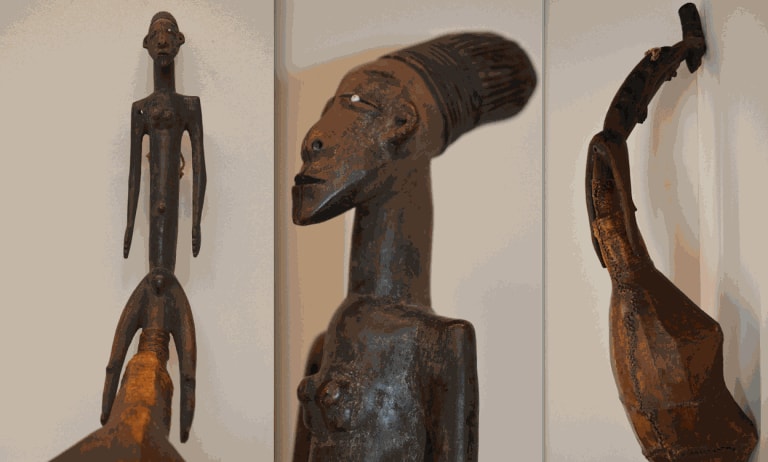
One often hears the claim that all major African works of art are known by now. But we Belgians (and the French too of course) know better. Every now and then something major pops out of nowhere, and today was such a day again. The small Brussels auction house Beguinage sold a previously unknown Mangbetu harp with an anthropomorphic column for a small fortune: it was hammered down for € 300,000 (so ca. € 360,000 with costs), selling to a French dealer (a Belgian colleague being the underbidder). Once again a clear prove that it doesn’t matter how small or obscure the sale is, if it’s good it gets noticed. Note that is has been a while since I posted about sleepers at auction..
Coming back to this harp, Georg August Schweinfurth gave a beautiful description about the importance of music in the local daily life when he visited the Zande and Mangbetu region between 1867 and 1871:
‘Apart from the special characteristics that distinguish them, more or less pronounced marks of race that pick out the different groups of the human family, the Niam-Niams are men of the same nature as others; they have the same passions, the same joys, the same pains as us. I have exchanged any number of jokes with them, I have taken part in their childish games, accompanied by the sound of their drums or mandolins, and I have found in them the same gaiety and verve found elsewhere.’ (“Au Coeur de l’Afrique. Trois ans de voyages et d’aventures dans les régions inexplorées de L’Afrique Centrale (1868-1871)”, Le Tour Du Monde, Nouveau Journal des Voyages, Vol. 28, 1874: p. 210)
‘But the Niam-Niamshave other pleasures; they have an instinctive love of art, and owe to it more elevated pleasures. Passionate about music, they extract from their mandolins sounds which resonate in the deepest fibers of their being and which thrown them into genuine intoxication. The concerts they offer themselves are of unimaginable lengths. Piaggia has said that a Niam- Niam would play his instrument for twenty-four hours without leaving it for a second, forgetting to eat or drink; and even though I know well this people’s appetite, I believe Piaggia was right. Their favorite instrument is related at once to the harp and mandolin. It resembles the former by the disposition of its strings and the latter by the form of the body. Built precisely according to the laws of acoustics, the soundboard has two openings. The strings, solidly held by pegs, are sometimes made of vegetable fibers, sometimes of giraffe tail-hair. As for the music played on these mandolins, it is highly monotonous; it would be difficult to discern in it the slightest semblance of melody. It is never more than an accompaniment to a recitation, sung in a plaintive (even whining) tone, and of a decidedly nasal timbre. I have many times seen friends going arm in arm playing this way, beating time with their heads, and plunging each other into a profound ecstasy.’ (op. cit., 1874: pp. 222-223)
Unfortunately there don’t exist recordings of Mangbetu harp music.
UPDATE: Amyas Naegele was kind enough to share this short vintage recording of this type of harp: